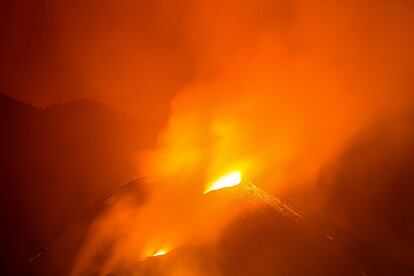In La Palma, rain forecast triggers concerns of torrential waters forming over lava
Authorities have advised residents to remove ash from their rooftops to avoid a heavy buildup. Spanish PM Pedro Sánchez is expected to fly to the island on Saturday

Spanish Prime Minister Pedro Sánchez is expected to fly to La Palma on Saturday to survey the latest damage from a volcano that has already destroyed 2,122 buildings and razed 886.6 hectares of land, according to the latest data from Copernicus, the European Union’s Earth observation program.
It will be Sánchez’s fifth visit to this area of the Canary Islands, off the northwest coast of Africa, since volcanic activity began on September 19 in Cumbre Vieja, a natural park in southern La Palma. A month later, the volcano shows no signs of letting up, fueling fears of further destruction.
A rain forecast for northern La Palma has triggered concerns about torrents of water that could form over the water-resistant lava, said the National Security Department (DNS). In Tazacorte, one of the hardest-hit municipalities, there is a 95% chance of rain on Saturday, according to the national weather service Aemet. Officials from the Canaries Volcano Risk Prevention Plan (Pevolca), which is overseeing the crisis, have advised residents to clean the ash off their rooftops to prevent it from mixing with the rain and creating a heavy buildup that could damage structures.
The DNS report also notes that lava streams in the northwest have now merged and appear to be heading in a southwest direction. Another tongue of lava that is near the sea was just 100 meters from the shoreline on Thursday morning, raising concerns about the toxic clouds that could form on contact.
A team from the Canaries Volcanology Institute (Involcan) has shared a video with close-up images of an eruptive vent in the volcano, noting that this is the first time that volcanologists have reached the site.
Por primera vez un equipo de vulcanólogos accede a la fisura eruptiva para comprobar sus características / for the very first time a team of volcanologists reaches the eruptive fissure to check its main features pic.twitter.com/7pPZ7srbcT
— INVOLCAN (@involcan) October 21, 2021
A total of 46 quakes were registered by the National Geographic Institute (IGN) between midnight and 7.30am on Thursday. The largest one took place at 6.09am at a depth of 14 kilometers in Fuencaliente, measuring 3.6 on the Richter scale. Most of the seismic activity of the last few weeks has been taking place in the area of Fuencaliente and Villa de Mazo, in southern La Palma.
María José Blanco, the scientific spokeswoman for Pevolca, said on Thursday that fewer tremors are taking place, but noted that their magnitude remains high, which could lead to “mildly harmful” events such as falling objects, the EFE news agency reported.
The Spanish Cabinet earlier this month approved a €214 million relief package to help rebuild homes and businesses. Although no fatalities have been reported – scientists had warned in advance about the upcoming eruption – the lava streaming down from the volcano has swallowed up entire neighborhoods and numerous banana plantations on an island where the economy is highly dependent on agriculture. Thousands of people have been evacuated, the latest on Wednesday in La Laguna. The most affected parts of the island include the municipalities of Tazacorte, El Paso, Fuencaliente, Mazo and Los Llanos de Aridane, which are home to 35,000 people.
Tu suscripción se está usando en otro dispositivo
¿Quieres añadir otro usuario a tu suscripción?
Si continúas leyendo en este dispositivo, no se podrá leer en el otro.
FlechaTu suscripción se está usando en otro dispositivo y solo puedes acceder a EL PAÍS desde un dispositivo a la vez.
Si quieres compartir tu cuenta, cambia tu suscripción a la modalidad Premium, así podrás añadir otro usuario. Cada uno accederá con su propia cuenta de email, lo que os permitirá personalizar vuestra experiencia en EL PAÍS.
¿Tienes una suscripción de empresa? Accede aquí para contratar más cuentas.
En el caso de no saber quién está usando tu cuenta, te recomendamos cambiar tu contraseña aquí.
Si decides continuar compartiendo tu cuenta, este mensaje se mostrará en tu dispositivo y en el de la otra persona que está usando tu cuenta de forma indefinida, afectando a tu experiencia de lectura. Puedes consultar aquí los términos y condiciones de la suscripción digital.
More information

New areas evacuated on La Palma as lava destroys more homes

One month on, La Palma volcano continues to cause destruction
Últimas noticias
Most viewed
- Reinhard Genzel, Nobel laureate in physics: ‘One-minute videos will never give you the truth’
- Oona Chaplin: ‘I told James Cameron that I was living in a treehouse and starting a permaculture project with a friend’
- Pablo Escobar’s hippos: A serious environmental problem, 40 years on
- Chevy Chase, the beloved comedian who was a monster off camera: ‘Not everyone hated him, just the people who’ve worked with him’
- Why we lost the habit of sleeping in two segments and how that changed our sense of time








































